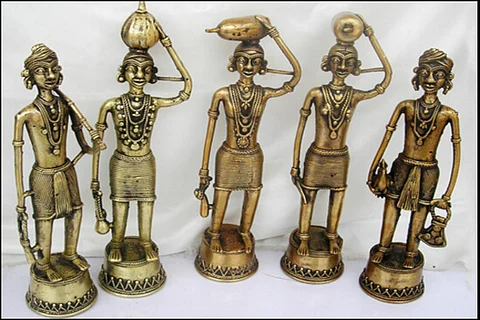

Telangana can celebrate as two more craft forms that are unique to the state were granted the Geographical Indication (GI) tag by the GI registry in Chennai.
Adilabad Dokra, an ancient metal craft that is popular in the state’s tribal regions, and Warangal durries or rugs, which are woven in handloom clusters in Warangal and Pochampally among other areas, have now been declared unique to the region.
Adilabad Dokra
The uniqueness of this art form is that no two sculptures are the same, as they are not made out of a pre-designed cast.
The craftsmen of this art form belong to the Woj community, commonly referred to as Wojaris or Ohjas in the rural areas of Telangana. There are roughly 100 odd families in Adilabad district who are involved in the art form. They use brass as their main material and an ancient casting technique called ‘cire perdue’.
As part of this technique, the craftsmen use clay and design a model of the sculpture that they want to create. They wrap the clay with wax threads before baking the mould, so that the wax melts away and the molten metal is poured into the mould.
The common items made by the craftsmen include small idols and statues of tribal deities, jewellery, bells, small-scale animal sculptures and others.
Warangal durries
In this style of durries, weavers create beautiful patterns and dye them using vegetable colours, which are washed in flowing water after the printing process.
Warangal district became a renowned hub for weaving these rugs due to the availability of cotton, which is grown by farmers in the area.

Image courtesy: Pitta Ramulu/Amazon.in
These fine craftsmen are well known all over, as their durries have managed to become popular across India as well as abroad.
There are reportedly more than 2,000 weavers in Telangana whose products are being exported to the UK, Germany, US and a few other European and African countries.
According to the Handloom Export Promotion Council, 80% of the handwoven durries sold in European and American markets are woven in India.
Last year, e-commerce giant Amazon signed a Memorandum of Understanding (MoU) with the Telangana Department of Handlooms and Textiles to help the weavers sell their durries online.
The state government had filed applications for the GI tag in March 2015, but the registry granted the tag only in March this year.
Once a GI tag is allotted to a product, the name becomes unique to that geographical area and cannot be used for products that are manufactured outside of it.
Violation of GI tags is a punishable offence under the law.
In Telangana, the Silver Filigree of Karimnagar, Hyderabadi Haleem and Narayanpet Handloom Sarees already enjoy the GI tag among other crafts. Last year, the famous ‘Hyderabadi biriyani’ failed to get a GI tag, as it could not prove its historical origin.
In Andhra, the famous ‘Tirupati laddu’ offered as prasadam at the Sri Venkateshwara temple atop Tirumala already enjoys the GI tag, along with the Banganapalle mango and the Durgi stone carvings, among others.